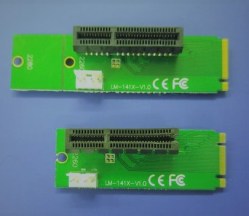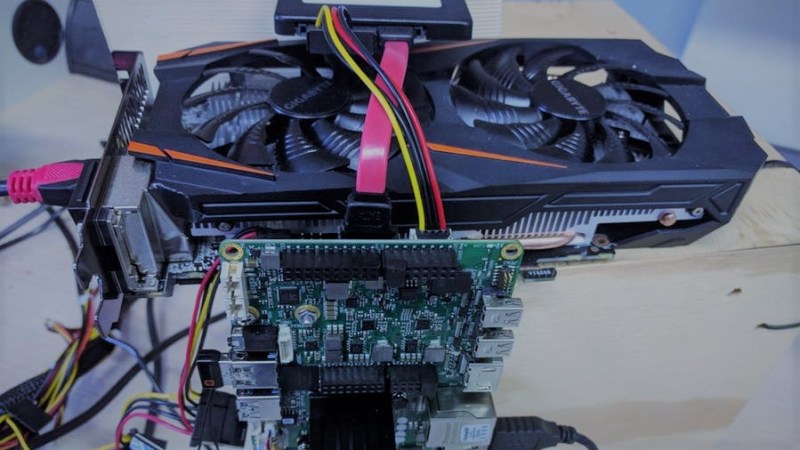It’s about convenience when it comes to single board computers. The trade-off of raw compute power for size means the bulk of them end up being ARM based, but there are a few exceptions like the x86 based Udoo Ultra. The embedded Intel 405 GPU on the Udoo Ultra is better than most in the category, but that won’t begin to play much of anything outside of a browser window. Not satisfied with “standard” [Matteo] put together his build combining an Udoo x86 Ultra with a NVIDIA 1060 GPU. It seems ridiculous to have an expansion card almost three times longer than the entire computer its attached to, but since when did being ridiculous stop anyone in the pursuit of a few more polygons?

Since the Udoo Ultra doesn’t feature a PCIe slot [Matteo] slotted in a M.2 to PCIe adapter board. There are two PCIe lines accessible by the Udoo Ultra’s M.2 port although trimming the adapter board was required in order to fit. The PCIe female slot was cut open to allow the 1060 GPU to slide in. All of the throughput of the 1060 GPU wouldn’t be utilized given the Udoo Ultra’s limitations anyway.
Windows 10 was the OS chosen for the machine so that all those NVIDIA drivers could be installed, and there’s also the added benefit of being able to sneak in a little Trackmania Turbo too. So to accompany the build, [Matteo] created a graphics comparison video to show the remarkable improvement over the embedded graphics chip. You can see the Time Spy benchmark results in the video below.
















A year ago people would be making comments about how this has potential for use in cryptocurrency mining.
I look at it and see huge potential for neural networks.
Depending on the final price (later this month) I’d probably go with the Odroid-H2 (which will uses more power) for ~40% extra CPU number crunching ability and you can upgrade the RAM to 32GB. But I’d need to see the final price when they release the board to be sure.
https://www.cpubenchmark.net/compare/Intel-Pentium-N3710-vs-Intel-Celeron-J4105/2730vs3159
Curecoin and Foldingcoin are still not minable with ASICs, so such a setup would still be useful for those coins.
And yet here we are, still making comments about mining computer money. Well done!
It’s a lot of fun, especially if you know how to break even on investments quickly. I’ll never forget the time 3 years ago when I built a small cheap smartphone cluster that paid for itself in a week mining Perk…
…10 years ago Slashdot would be full of, “imagine a Beowulf cluster of these!”
Seems like it could be useful for a render farm though, right? I mean you basically have a GPU with an Ethernet port.
this is stupid.
i want one.
same
It’s a nice hack, but one of these would have been easier/cleaner: https://www.ebay.com/itm/271112951715 or one of these to also ease/clean up the power connections: https://www.ebay.com/itm/311980593462
Those are only PCIe x1, the M.2 slot on this SBC supports PCIe x2.
I stand corrected.
Mini STX is a thing, tough to find the board outside a deskmini. But its a lot more expandable. Think Mini ITX in. 5.5×5.9 footprint. It also needs this kind of m.2 thingy for a video card, but you pick real processors, skylake/kabylake
Am I missing something? Could easily do this with an asrock j5005-itx for half the price
this isn’t savemoneytoday.com
In fact most of these shenanigans end up costing more than just buying it “the normal way”, but that’s not why we’re here.
how about arm mini computer and gpu:s? i want see running
There are a few reasons ARM would be a problem. As much as I wish PCIe were more common on ARM, the SoC approach and the fact that PCIe is not a core technology in the same way as it is on x86 means it’s rarely available.
The next issue are drivers and the lack of OSS drivers you could compile for ARM. That would also depend on the SBC’s linux distro either providing all the source needed to build the GPU driver into the kernel, or having solid KLM support to load the driver without having to recompile the kernel.
There might be something out there, but the most popular SBCs don’t seem like good candidates.
There are lots of older, but still fast, used graphics boards becoming available as computers are upgraded/replaced.
There has to be some nice hacks we can do with the old video cards.
The one nice thing about the 10 series cards is the low power usage. I have a 1080 and it blows my old setup with two 780s in SLI and uses less power than one card. Drop down to a 1060 and even less power. Really he could have used a 1050 and probably get the same performance.
So I don’t fully understand the PCI express lanes, but if the card supports 16 and only 2 are supplied is there any advantage to the higher end card? Wouldn’t a cheaper card give the same performance?
The GPU can still crunch numbers fast, having 2 PCIe lanes only limits how fast numbers can be pushed on to and off of the card.
For gaming the use of only 2 lanes would likely be a bottleneck. However, for many GPU compute applications that are mostly number crunching, it likely wouldn’t matter.
Most cryptocurrency mining use very little PCIe bandwidth and that’s why x1 to x16 extender kits are so common.
actually youd be surprised how little only having 2x lanes affects gaming performance, its not that big of an impact, my thinkpad P52s only has 2x lanes available on its TB3 connection but my 1070 eGPU only loses about 15-20% of what it would get in a desktop system, its more than capable of gaming at very nice settings even on the internal display
Not only can the GPU itself do a LOT of crunching if you optimize the task, it also has a much faster RAM interface then what you’d find most x86 machines. The comms to it will be too slow to ever utilize it like the manufacturer intended, but then again this is not exactly a standard use case.
Something like a Jetson TX2 would still offer OK performance and would be a hell of a lot smaller and neater.
It’s significantly more money though. I’d also wonder about driver support in their Linux distro for this product (though their Drive PX2 which is the same SoC is paired with external GPUs).
Correction, the GPUs on the nVidia automotive based products connect via NVLink, not PCIe so they may not have a way for an external GPU to function on PCIe in any of their Tegra X2 products.
It would be interesting if this could be taken to an extreme where the x86 system can be mostly hidden so it looks like just a GPU playing games without a computer attached :)
Get *really good* at soldering then connect fine wires to the very bottom of the card’s edge connector contacts. Build an acrylic case (with plenty of vent holes) on a wooden base. A slot in the top of the base allows the card to sit just low enough to hide the soldered on wires while the wee little computer hides in the base.
It’s unfortunate that a single board computer with thunderbolt 3 doesn’t exist. Imagine an eGPU…
Doesn’t that Mac Mini count?
With the 2 lane bottleneck a GTX 1050 mini would be just as much overkill while being more compact and cost less.
For cryptocurrency mining, not even a 2080Ti will bottleneck.
It would be interesting to see how this performs with blender cycles rendering. Compared to a PC, I’m sure the power consumption difference would turn this into a viable, cost effective rendering solution/node.
Just use an udoo bolt with a ryzen and you’ll get much better performance cuz there’s far less bottlenecking with that cpu
I like this.
With those Time Spy results lower than a typical 1030 Time Spy result, I’d like to see a 1030 on it to see if the result lower by much and I’d like to see a 2080Ti on it, just because.